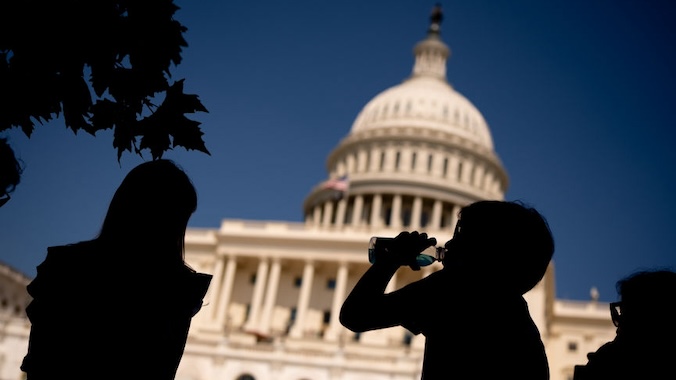Can a National Heat Strategy Fight Back Against Climate Change’s Deadliest Weapon?
Photo by Andrew Harnik/Getty Images
Extreme heat kills more people in the U.S. than flooding, hurricanes, and tornadoes — combined. Of all the various climate change impacts, increasing heat waves, hot nights, and dangerously hot days are the most obvious and most directly connected. But heat kills more quietly, and often more slowly, than a big storm or wildfire; the elderly or ill might just be sitting at home, not really knowing something bad was happening until it’s too late. We generally don’t get heat wave death counts until weeks or months after the fact.
As such, heat never quite gets the celebrity treatment we give to the flashier events — named hurricanes, flash flooding and tornado warnings blowing up your phone, round-the-clock cable news coverage, and so on. On Wednesday, the Biden administration launched an initiative aimed at changing that.
The first-of-its-kind National Heat Strategy has the relatively straightforward mission to “reduce heat-related impacts” and “ensure a thriving, heat-resilient nation.” Its main targets seem to be coordination and communication — if both government agencies and citizens have an increased awareness of the risks, maybe they can be mitigated somewhat. Virtually every corner of government could have a role to play here, from the Census Bureau (“Provides publicly available data on demographics that can help identify populations most
impacted by extreme heat”) to the Department of Homeland Security (“Provides protection for critical infrastructure and emergency management support for extreme weather events to include heat emergencies”).
The Strategy highlights a number of potential solutions, including assessments to identify the most at-risk populations or areas, establishment of heat early warning systems not totally unlike those used for other forms of extreme weather, and the adoption of specific safety measures like protections for outdoor workers. There is also an entire section on science, with the goal of better understanding heat’s specific impacts.
The document joins a widening conversation on the need to better address extreme heat on a warming planet. For example, there is a growing movement to start giving heat waves names, like hurricanes (and, less officially, winter storms, to much derision), in the hope that it would wake people up to the danger they bring. Researchers published results of a sort of pilot project in this vein, with a heat wave in Spain in 2022 dubbed Zoe — they found that while only six percent of people responding to a survey independently recalled the event’s moniker, those who did demonstrated “greater engagement in heat wave safety behaviors.” Other places have followed suit, like in Greece and Cyprus where one heat wave earned the name Cleon.
Experts with the World Meteorological Organization, however, have pushed back against the concept, warning against simply taking a risk communication practice from the world of tropical cyclones and haphazardly throwing it against the heat wave wall. It could result in complacency when confronted with a heat wave that does not garner a name, or just general confusion over a named event’s potential in a given location.
The new National Heat Strategy will also have some uphill battles to climb. For example, protections for people working outside in extreme heat sounds like a no-brainer, but no-brained state governments like that in Florida have other ideas: a state law went into effect in July that bans such heat protections entirely. Still, it’s comforting to see the government take the most obvious but least discussed climate impact this seriously; as temperatures soar the “unprecedented” or “impossible” heat waves will proliferate, and a proactive approach to managing their fallout will likely save lives.